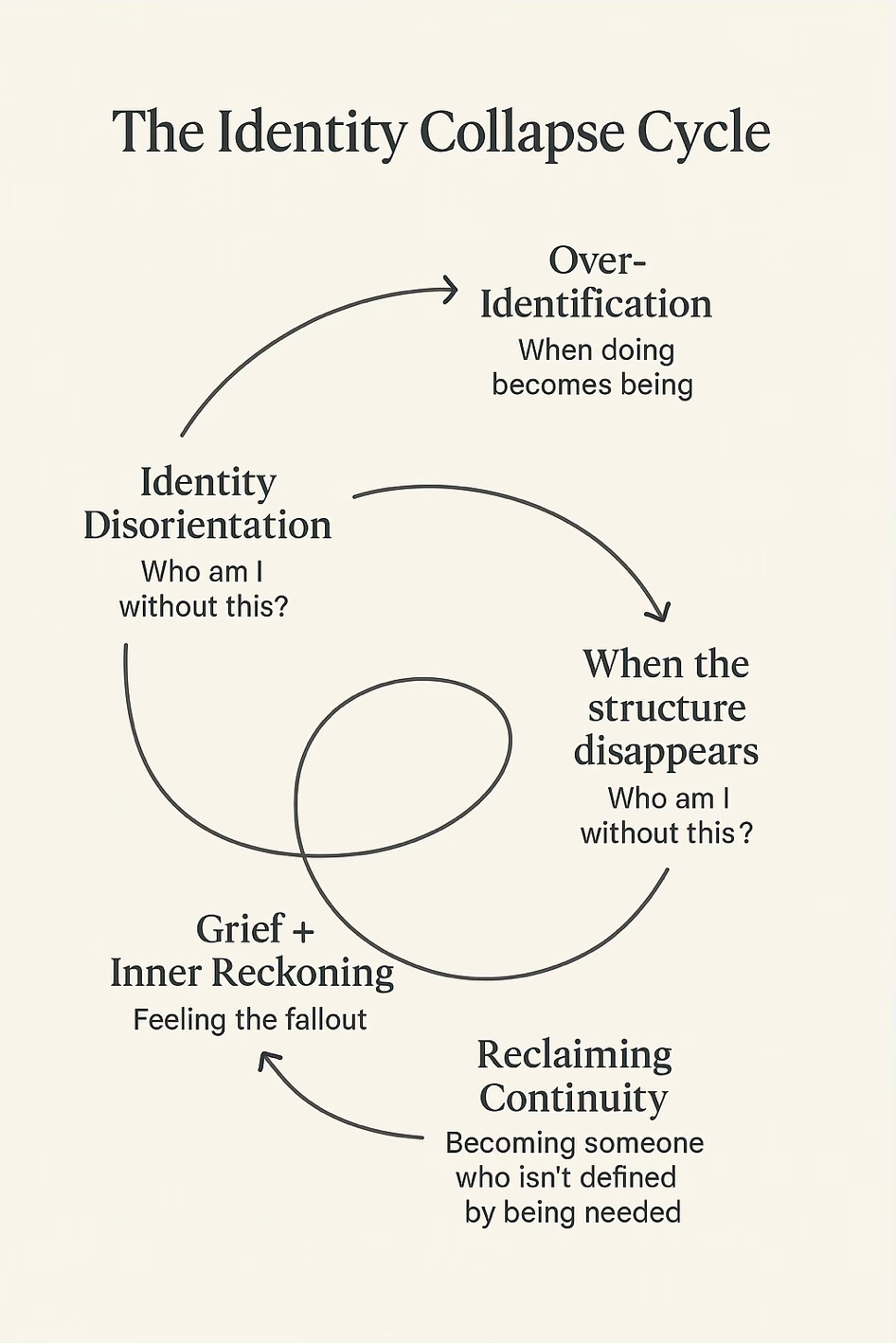The Dissolution of Identity
When we break down who we are, we create space to become something new
I've spent this past year thinking deeply about identity — not in the casual sense of job titles or personality types, but in the deeper sense of what holds us together. These last three weeks of writing about "When to Leave" brought that exploration to the front of my mind. Identity emerged as the hidden thread connecting all three pieces.
The Structure of Identity
Let’s start by looking at what identity actually is: Identity is both the architecture of our lives and the hidden constraint on our possibilities. It gives us coherence, but it also edits what we can see, feel, and imagine for ourselves. Most of the time this editing remains invisible to us, and feels as natural as breathing.
Let me give you an example: One of my friends offers me help. And before the words even register, I've already said no. Not because I weighed the offer and rejected it, but because my sense of self is bound up in being capable. To accept help would threaten that story (identity) about who I am as a capable woman.
Identity doesn't only work by rejecting what threatens it. Sometimes it operates by making certain possibilities completely invisible, filtering them out before they can even register as options. These unconscious choices shape our reality before we even realize there was a choice to be made.
How Identity Shapes What We See
Does this unconscious editing process have a name? Oh yes it does, it’s known as top-down processing. Rather than passively receiving objective information, our brains actively filter perception through existing beliefs and expectations. What we think of as reality is actually reality shaped by the story of who we are.
William James, writing more than a century ago, described the self as both the "I" who experiences life moment by moment and the "me" who records it into a coherent story. That record-keeper doesn't just observe — it actively shapes what gets recorded to match its own narrative.
The power of this shaping becomes visible only in retrospect. In one stage of my life I could only see myself as the dependable one, which excluded every possibility requiring risk or uncertainty from my awareness. Later, when circumstances pushed me beyond that role, I began noticing choices I couldn't even perceive before. What had changed wasn't the world, but the lens through which I was seeing it.
The Collapse of Identity
This is why identity collapse matters so much for personal growth. Eventually, every identity reaches a breaking point in our lives. The marriage ends, the career unravels, the children grow up and leave home. Suddenly the story we built around ourselves can't hold anymore.
While many women view this as a crisis, I've come to see collapse as part of the natural rhythm of growth. When identity begins to break down through loss or erosion, the perceptual walls loosen. The experiences we've always been blind to begin showing up in our awareness. It feels overwhelming, even frightening, because the old editing system is gone. But it is also the beginning of freedom from those constraints.
I've lived through these collapses in my own life. At first they felt like failures, as if I'd lost my footing in the world. But with time, I began to see them as invitations to something larger. The walls that kept me safe were also keeping me small and limited. When those walls crumbled, terrifying as it was, something else could finally come through.
The Dissolution of Identity
Collapse isn't enough to create lasting change, though; we’ve got to keep going deeper. Waiting for life to tear down our walls leaves us at the mercy of whatever comes next. Growth also requires conscious engagement with the boundaries we've created for ourselves.
Every identity we hold is partial by nature. It describes some aspects of who we are but excludes many others from consideration. To grow beyond current limitations, we have to actively challenge those exclusions. That means asking the uncomfortable questions that threaten our sense of who we are:
Who am I beyond being the reliable one in every situation?
What possibilities open if I am not defined by my history of failure?
What if the labels I've clung to most tightly are simply stories I've repeated long enough to believe?
Dissolving identity is about softening the walls long enough to let new experiences through our defenses. I think of it as an experiment in possibility. Temporary, deliberate, designed to reveal what the old self cannot see or experience.
The Edges of Me: A Practice in Identity Exploration
Lakota psychologist and narrative therapist Dr. Louis Mehl-Madrona observes that old stories often have to collapse before new possibilities can take root. He explores how people who lose their "core story" often find themselves bewildered at first. Then they become newly able to reimagine who they are beyond those old constraints.
From his work, I've developed a practice called The Edges of Me. It moves beyond observation into active experimentation with the boundaries of self. This practice emerged from my own need to find the boundaries of who I thought I was and deliberately cross them.
You can download this as an activity (export to PDF) or copy it to your Notion space as an interactive activity. Please be mindful, this is ADVANCED work.
Living Without Fixed Identity
Identity will always rebuild itself. That's its nature. When we stop clutching identity as absolute truth, we make space for surprise. We stop defending yesterday's version of ourselves. We allow life to show us what else is possible. This is the beginning of freedom. Not the freedom from identity, but the freedom to let it evolve.



